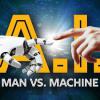
Breaking News
 Kash Patel SHUTS DOWN Charlie Kirk Investigation By Tulsi & DNI!
Kash Patel SHUTS DOWN Charlie Kirk Investigation By Tulsi & DNI!
 BREAKING: Secret Study Conducted By Henry Ford Health Conclusively Proves...
BREAKING: Secret Study Conducted By Henry Ford Health Conclusively Proves...
Discovering Gems of Understanding
 Trump's Corporate Favor Factory
Trump's Corporate Favor Factory
Top Tech News
 Graphene Dream Becomes a Reality as Miracle Material Enters Production for Better Chips, Batteries
Graphene Dream Becomes a Reality as Miracle Material Enters Production for Better Chips, Batteries
 Virtual Fencing May Allow Thousands More Cattle to Be Ranched on Land Rather Than in Barns
Virtual Fencing May Allow Thousands More Cattle to Be Ranched on Land Rather Than in Barns
 Prominent Personalities Sign Letter Seeking Ban On 'Development Of Superintelligence'
Prominent Personalities Sign Letter Seeking Ban On 'Development Of Superintelligence'
 Why 'Mirror Life' Is Causing Some Genetic Scientists To Freak Out
Why 'Mirror Life' Is Causing Some Genetic Scientists To Freak Out
 Retina e-paper promises screens 'visually indistinguishable from reality'
Retina e-paper promises screens 'visually indistinguishable from reality'
 Scientists baffled as interstellar visitor appears to reverse thrust before vanishing behind the sun
Scientists baffled as interstellar visitor appears to reverse thrust before vanishing behind the sun
 Future of Satellite of Direct to Cellphone
Future of Satellite of Direct to Cellphone
 Amazon goes nuclear with new modular reactor plant
Amazon goes nuclear with new modular reactor plant
 China Is Making 800-Mile EV Batteries. Here's Why America Can't Have Them
China Is Making 800-Mile EV Batteries. Here's Why America Can't Have Them
Got Trees? Here's How to Grow Food in a Shade Garden

My entire lot is 59' square, and my house sits on a large chunk of that. I've turned as much as possible to food production and you can too. This article will deal with the shady garden areas. What can be grown in the shade garden, and how?
What is a shade garden?
Shade is a relative term of course. Shade gardens are usually areas with little or no direct sunlight. This can be an area near a building or under a tree and is often used as an ornamental area. There are, however, many flowers, greens, and herbs that grow well in such areas. Spinach actually prefers the cooler area.
According to Swanson Nursery, other edible items include arugula, endive, lettuce, sorrel, collards, kale, mustard greens, Swiss chard, beets, carrots, potatoes, radishes, rutabaga, turnips, brassicas such as broccoli and cauliflower, Brussels sprouts, and cabbage. Herbs such as mint, chervil, chives, coriander/cilantro, oregano, and parsley will do well in a shade garden.
In my experience, the brassicas do better in direct sunlight and also need lots of room. Potatoes ditto. these prefer cooler temperatures but lots of sunlight and again, room to spread and form tubers. But 3-4 hours of sun will still produce something, and that's better than nothing. You might also consider alliums such as onions, leeks, and garlic.
What can I grow?
How big is your space, and what's the soil like? This will dictate what can be grown there and how. If the space is small, then the alliums mentioned above, along with the greens and herbs might be your best option. The smaller root vegetables mentioned above will also work in small spaces, and best of all, the greens of beets, carrots, and radishes are all edible! Your shady garden can serve as a cut-and-come-again garden. Just be sure to leave at least 1/3 of the leaves so the plant can continue to grow and produce.

 China Innovates: Transforming Sand into Paper
China Innovates: Transforming Sand into Paper

